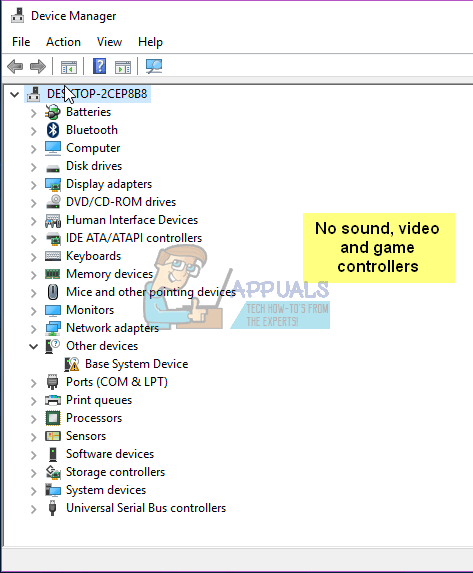Fix: Missing ‘sound, video and game controllers’ in Device Manager
When you get a malfunctioning sound system on your PC, the first place you head to check if everything is working okay is the device manager. Usually, there are several categories you can expand into, including graphic adapter, serial buses, keyboard and pointing devices, among others. One such category is the sound, video and game controllers section. As the name suggests, all your sound video and game controllers are installed and listed under this section.
What does it then mean when you find the sound, video and game controllers section is not listed? This question has bugged a lot of users that need to access the sound drivers on their PC in order to clear errors and missing sound when they play their audio and video files. This article will explain why the sound, video and game controller section is missing, and how to get it back. This will also likely solve your sound issues.

Why the sound, video and game controllers section is missing in device manager
The reason why the sound video and game controllers section might be missing on your computers, is that windows was unable to find any installed sound cards; therefore there is nothing to display. Missing sound cards can be caused by uninstalled sound card drivers, bad sound card drivers or a malfunction in sound card drivers. This is a common issue when upgrading from previous version of Windows to Windows 10. Drivers from the previous versions may not always be compatible with Windows 10; therefore your PC will not recognize your sound card.
If your sound card is not damaged or has not been unplugged from the PC, here is how to solve this issue:
Method 1: Run sound and hardware troubleshooter
Troubleshooter is likely to find the best sound drivers for your PC and install them automatically for you. It will be a good idea to have an internet connection so that the troubleshooter can search for drivers online.
- Press the Windows logo key + R to open the Run dialog box.
- Type control in the Run dialog box, then press Enter.
- In the Search box in Control Panel, type troubleshooter, and then click Troubleshooting.
- Under the Hardware and Sound item, click Configure a device. If you are prompted to enter an administrator password or provide confirmation, type the password or provide confirmation.
- Press Next and let the troubleshooter scan for problems. Fix all emerging problems.
- You may have to restart your PC

Method 2: Install drivers manually
If troubleshooter doesn’t install your drivers, you might try installing the sound drivers by manually invoking device manager to look for your sound card drivers. Connect to the internet for better results.
- Press the Windows logo key + R to open the Run dialog box.
- Type devmgmt.msc in the Run dialog box, then press Enter. If you are prompted for an administrator password or for a confirmation, type the password, or click Allow
- Since your device is missing, it might not be visible to you. From the device manager window, click View and select show hidden devices (unless it already has a tick on the left). If you still don’t see your device, click on Action then select scan for hardware changes.
- Your sound device is likely to be listed under ‘Other Devices’ (usually lists uninstalled devices) with a yellow triangle on it.
- Right click on the device and select, “Update Driver Software”
- Click on “Search automatically for updated driver software” to allow an automatic search
- Let the computer search for the drivers and install them.
Method 3: Look for your sound drivers online and install them
If you are unable to resolve the issue above automatically, you will have to find and install your drivers manually.
- Go online to your computer manufacturer support page and find drivers for your sound card e.g. you can find Toshiba Realtek audio drivers here
- Double click on the drivers to install them. Other types of drivers require you to extract them from a zip file then click on the installer/setup file in order to install them.